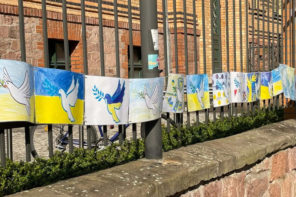This short essay is an invitation to question how different forms of political engagement destabilize institutional processes of evidence making. In the workshop that motivated this collective reflection, we discussed the struggles that ethnographers undergo in finding a language to speak about “facts” and “evidence” in fieldwork sites from Palestine to Kashmir, from Scotland to Cyprus, from Lebanon to Ecuador, from Italy to Chile, and many more. What emerged from these conversations was a focus on how ethnographic and historical understandings of “truth” challenge legal and scientific claims, and why these competing truths are paramount for any politically engaged anthropology of evidence. Our focus here, then, is on evidentiary regimes illuminated through ethnographic collaborations around disappearance, dispossession, and massacre. We offer a conversation about how “facts” and “evidence” are deployed and contested on the ground. This approach, we hope, can help illuminate the relationship between justice, power, and knowledge that goes beyond instrumental theorizations of violence. To do so we present a reflection each on: ways of speaking truth to power in courts; everyday forms of evidence contestation; and counter-evidence production with statistics and data visualizations. In doing so, our aim is to break open the categories of fact and evidence by paying attention to stories often overlooked from processes of evidentiary production.
Speaking truth to power
In Indian Administered Kashmir, which has long endured violent Indian military occupation and witnessed a decades-long armed resistance movement, it was common in daily conversation to talk about extrajudicial killings, torture, forced disappearances, illegal detention, random interrogation and raids. In such conversations, the families of victims of human rights violations on the part of the state often narrated the dilemma of seeking redress from the legal machinery of the very same state that had perpetrated violence against their kin. If desire for “justice” won out, then families would encounter a dizzyingly obtuse legal infrastructure that required the assistance of lawyers, activists and journalists to navigate in the struggle to speak truth to power. As such, the practice of excavating the “truth” about the event of the violence and injustice against the victim becomes an important part of the process to be presented as evidence legible in a court of law.
In a geography of relentless cycles of violence, this practice of establishing claims to “truth” and evidence making is not limited to singular legal cases of human rights violations. This process becomes an important part of the Kashmiri political movement and its strategies of resistance to assert the “true” history and the “true” consequences of historical events for their articulation and demand for justice. In other words, the task of asserting the “truth” or act of speaking “truth” to power becomes part of the archive building process of evidence against the oppressor, usually with complete acknowledgement of the fact that “truth” is hardly singular to any one social or political movement and history.
The practice of excavating the “truth” about the event of the violence and injustice against the victim becomes an important part of the process to be presented as evidence legible in a court of law.
For instance, activists collaborating with local human rights documentation groups working in Kashmir on cases of enforced disappearances, mass graves and other human rights violations, often cite how they constantly navigate through the “facts” available from victim and kin testimonies as well as the process of presenting these testimonies as “evidence.” Whether the human rights groups document and prepare dossiers for legal battles seeking justice in courts run by the same state that oppresses them, or whether the human rights violation cases are documented for advocacy and awareness-raising at international platforms like the United Nations Human Rights Commission, the presentation of evidence follows a legal framework to validate its authenticity and credibility. The process of presenting evidence that would help the families of the victims testify against the perpetrators of violence and stand the scrutiny of factuality and verifiability in the court of law also becomes a method to claim urgency, authenticity and ethicality of seeking justice for the victims. In a way, the process of seeking justice through the translation of “truths” into a legally legible vocabulary becomes the repertoire of the larger political movement for justice and dignity.
The process of seeking justice through the translation of “truths” into a legally legible vocabulary becomes the repertoire of the larger political movement for justice and dignity.
The evidence building process, then, is neither self-evident nor a linear trajectory of accumulating facts to be transformed into evidence for legal battles seeking justice. Many contemporary political movements strive towards documenting and archiving facts for articulations of their protests and struggles, thereby presenting “facts” as “truths.” This makes the process of working with “facts” and “evidence” a discursive process: one that constantly debates, imagines, and carves out evidence within the political and social context in which it is embedded.
Ruins as evidence: when facts fail to speak for themselves
When activists speak in terms of facts and evidence to make claims on political elites, they evoke a discursive regime that is conventionally state-centric, evoking relations of power that often work against them. This was the case for the villagers of Lurucina in Cyprus, for whom the ruins in their village denote both longstanding predicament and an impending catastrophe.
The Turkish Cypriot village of Lurucina, the southernmost point of the de facto Turkish Republic of Northern Cyprus (TRNC), appears on the map as an outgrowth into the Greek Cypriot-controlled territories. The “border” that surrounds Lurucina came into being after the 1974 war, cutting the villagers off from the surrounding Greek Cypriot towns with which they traded, and occasionally also fought. This separation defines the everyday life of Lurucina’s remaining inhabitants, and they blame it for the village’s contemporary troubles: a population drain and spatial decay caused by Lurucina’s “remoteness” (uzaklık) from the rest of the TRNC to the north and by its “severance” (koparılması) from the south.
According to the remaining villagers, this border “encamped them in a corner” (köşeye sıkıştırdı) and made everyday life in Lurucina exceedingly difficult after 1974, causing most people to leave. Only about 300 people permanently reside in Lurucina now, and most of them are above 40. Before 1974, the village was home to about 3,000 people. The remaining villagers are quick to index their sense of loss by pointing at the abandoned and decaying houses that used to be occupied by “those who escaped” (gaçanlar). The abandoned open-air cinema of the village is often referred to as particularly poignant evidence for how Lurucina had been but was no more; a place of daily sociality, it now resembles a scrapyard (see photo). Besides acting as evidence of a community lost, these ruins are signs of things to come: the remaining villagers all agree that Lurucina is “dying” and will cease to exist once they grow old and pass away.
The villagers decided to act against this in 2020 with a campaign, directed towards political leaders to their north and south, for a border checkpoint that they hoped would revitalize trade and help attract youth back to Lurucina. They organized a protest at the border and called on Greek and Turkish Cypriots from other places to join them. Although the protest attracted several hundred people from outside, the villagers eventually considered their campaign unsuccessful because it failed to pressure the political elites to act. This was not necessarily because wider society was unaware of what the villagers wanted: on the contrary, they received a good amount of media publicity.
Besides acting as evidence of a community lost, these ruins are signs of things to come.
Their failure rested in having been unable to convince others that the village’s ruins were evidence of a community that was being “strangled” by the border. Aware of the protest but not having attended, one Turkish Cypriot man from the capital told me: “the villagers were never made to leave, they chose to leave for the cities in search of better houses and jobs.” This reinsertion of personal responsibility was a challenge to the villager-activists’ attempt to make the border the “cause” of their predicament and the ruins as its “evidence.” Instead, others pointed at some of the villagers’ ability to continue living in Lurucina as evidence that it was the “people,” and more specifically those who chose to leave, and not the border, that was the cause of decay. Instead of their argument, the villagers’ activism made their presence in the village evidence of the opposite: that it was still possible to live in Lurucina, but that most people simply chose not to.
The abandoned open-air cinema of the village of Lurucina, Northern Cyprus. Photo by Sergen Bahceci.
Evidentiary contestations and political engagement
In 2019, Kaleidos built a collaborative STS-inspired digital platform, called EthnoData, for the study of violent deaths, hate crimes, femicides, missing people, and prisons in Ecuador. Kaleidos is a centre for interdisciplinary ethnography producing grounded theory midway between anthropology and science and technology studies. Its goal is to connect local and global concerns by leveraging international research networks to produce politically-engaged and responsive scholarship from the global South. EthnoData is a multimodal and multimedia website that combines large datasets with ethnographic material that allows users to create their own theorizations and stories with numerical evidence and qualitative data – including official statistics, legal archives, curated images, essays, videos, podcast, and other forms of ethnographic material. EthnoData’s research logic and ethnographic capacities has allowed Kaleidos to produce empirical counter-evidence that complicates official narratives and mass media spectacles. For instance, the platform helped uncover the complexities and politics of a prison massacre that government officials and the national press characterized as the result of bloody clashes between transnational prison gangs.
On February 23, 2021, 79 inmates were killed during a coordinated two-day prison riot staged in three cities. Prison killings are not unprecedented in the Ecuadorian context, and have been on the rise since 2018 (see EthnoData video). In response, the government declared a crisis in the prison system in 2019, deploying military troops to maximum-security penitentiaries across the country, and replacing public servants with police personnel. That same year, Kaleidos began an interdisciplinary ethnography on prison data and infrastructure, privatization and corruption, and life after confinement. This study works collaboratively with prisoners and former prisoners, their families, civil society organizations, and different government agencies.
Images from Jorge Nunez’s documentary in Ecuadorian prisons “Carcel Uno”. Photos by Francois “Coco” Laso.
The day after the massacre, Kaleidos met with human rights defenders and abolition activists to develop a collective response to recent events. The rather humble initial meeting evolved into the creation of a critical thinking and activist space called Alliance against Prisons. The prison data generated through EthnoData and analyzed by Kaleidos’ team led by Jorge Núñez was put at the service of various members of the Alliance. This is meaningful because, in Kaleidos’ view, it was crucial to join a plurality of critical voices to challenge the government’s take on the riots. According to the chief of National Police, Mexican narco-organizations have taken control over Ecuadorian penitentiaries and are managing their drug trafficking networks from behind bars. This explanation of the massacre puts the blame on prisoners and characterizes narco-violence as exterior to Ecuador. The evidence presented by the government was mostly based on police intelligence and security experts.
These ethnographies of evidence call our attention to the political labor behind justice seeking practices, struggles against decaying environments, and critical stories of data.
In Kaleidos’ view, the official narrative overlooks (or plainly hides) how the demobilisation of inmates’ syndicates, the dismantling of entrepreneurial prison economies, the creation of prison intelligence infrastructures, and the construction of supermax prisons away from urban centers, changed life behind bars, and particularly how these bureaucratic decisions and investments affected the dynamics of prisoners’ self-governance that kept penitentiaries in peace. Kaleidos, and EthnoData by implication, could not have made this intervention into the evidentiary regime of securitisation without working collaboratively with prisoners, former prisoners, and their families on the one hand, and the members of the Alliance against Prisons on the other. The Alliance’s interactions are not free of conflict. On the contrary, intellectual friction is constant and most times productive. For instance, Kaleidos had an STS-inspired ethnographic approach to carceral infrastructures, while other activist-scholars came from long-term participatory action research experiences. These methodological differences had important implications in generating heated debates about what political engagement was and whether or not we had a common language to destabilize the evidentiary discourse informing official narratives about the prison massacre. In the end, the dialogue among members of the Alliance opened possibilities for contestations of the carceral state in Ecuador. We still think of prisons quite differently, yet we somehow found a space for cross-pollination and mutual support.
Conclusion
In thinking collaboratively about the experiences of evidence making in these three settings we have learned how evidence is produced and circulated in each local context. More importantly, we have brought together different ethnographic sites in which evidence becomes more than a legal claim. The Kashmir context complicates the idea that “truth” must navigate courtrooms in order to become, in fact, evidence. Activists must work against the legal system and its intrinsic ways for determining what counts as evidence in order to demonstrate that violence actually took place. In the case of Lurucina, in Cyprus, the efforts of mobilized citizens to bring attention to their need for a border checkpoint by foregrounding the degradation of their town ultimately countered their protest’s political agenda. What they viewed as evidence of their predicament – a visibly ruined and abandoned village – turned against them during their protest, being read instead by outsiders as evidence of the villagers’ own responsibilities and choices. Finally, in the case of Ecuador, counter-evidence to state narratives on brutal carceral violence was only possible through a complex (and never free of frictions) set of collaborations between numerous social organizations. Together, these ethnographies of evidence call our attention to the political labor behind justice seeking practices, struggles against decaying environments, and critical stories of data.
Featured image by Monica Silvestre courtesy of Pexels.com











